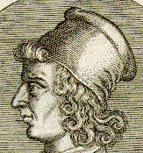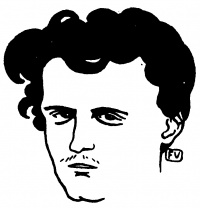Fancy portrait
From The Art and Popular Culture Encyclopedia
| Revision as of 13:01, 28 December 2011 Jahsonic (Talk | contribs) ← Previous diff |
Current revision Jahsonic (Talk | contribs) |
||
| Line 1: | Line 1: | ||
| - | [[Image:Marquis de Sade by H. Biberstein, 1866.jpg|thumb|right|200px|''[[Portrait fantaisiste du marquis de Sade]]'' ([[1866]]) by [[H. Biberstein]]]] | + | [[Image:Marquis de Sade by H. Biberstein, 1866.jpg|thumb|left|200px|''[[Portrait fantaisiste du marquis de Sade]]'' (1866) by H. Biberstein]] |
| + | [[Image:Imaginary portrait of Lautréamont by Vallotton.jpg|thumb|200px|right|[[Comte de Lautréamont]]]] | ||
| + | [[Image:Poggio.jpg|thumb|right|200px|[[Imaginary portrait]] of [[Gian Francesco Poggio Bracciolini]], | ||
| + | detail from the ''[[Bibliotheca chalcographica]]''.]] | ||
| {{Template}} | {{Template}} | ||
| - | :''[[imaginary]], [[portrait]], [[Imaginary portrait of the Marquis de Sade]], [[Vanessa (Millais painting)]]'' | + | '''Fancy portrait''' is an art historical term for an imaginary portrait of a real or [[literary character]]. The fancy portrait takes the form of a conventional [[portrait]] but is defined by the fact that its depiction of the character is derived from the artist's [[imagination]] rather than any authentic [[Recording|record]] of the person's [[physical appearance]]. Though imaginary portraits of [[historical character]]s have existed since antiquity, the term came into use in the nineteenth century, when "portraits" of literary characters became popular, and were widely reproduced in the form of engravings. It was also applied commonly to humorous [[caricature]]s and later to [[portrait photograph]]s (in the work of [[Julia Margaret Cameron]] for example) in which the subjects adopt imaginary [[persona]]s. |
| - | '''Fancy portrait''' is an art historical term for an imaginary portrait of a real or literary character. The fancy portrait takes the form of a conventional portrait but is defined by the fact that its depiction of the character is derived from the artist's imagination rather than any authentic record of the person's appearance. Though imaginary portraits of historical characters have existed since antiquity, the term came into use in the nineteenth century, when "portraits" of literary characters became popular, and were widely reproduced in the form of engravings. It was also applied commonly to humorous caricatures and later to photographs in which the subjects adopt imaginary personas. | + | ==Retrospective portraits== |
| + | '''Retrospective portraits''' is the title of a Wikimedia category containing "portrait of a person (usually a king from royal family gallery) who lived long before the creation of portrait, and the author of artwork hadn't any lifetime images of person at all for use as a source. So [the] portrait turned out absolutely [[fancy portrait|imaginary]]." [http://commons.wikimedia.org/wiki/Category:Retrospective_portraits]. | ||
| + | As of June 2013, the category featured such works as: | ||
| + | |||
| + | [[Poppaea Sabina (Musée d'Art et d'Histoire (Geneva))|Sabina Poppaea]], [[Laura by Giorgione]], Paintings by [[Antoni Boys]] in the Kunsthistorisches Museum, the [[Promptuarii Iconum Insigniorum]]. | ||
| + | |||
| + | ==Examples== | ||
| + | *[[Imaginary portrait of the Marquis de Sade]] | ||
| + | *[[Vanessa (Millais painting)]] | ||
| + | *Imaginary portrait of [[Hipponax]][http://jahsonic.tumblr.com/post/2582030515/imaginary-portrait-of-hipponax-from-the], from the "[[Promptuarii Iconum Insigniorum]] | ||
| + | *[[The "portrait" of Theophrastus ]] | ||
| + | ==See also== | ||
| + | *''[[Bibliotheca chalcographica]]'' | ||
| + | *[[Imaginary painting]] | ||
| + | *[[Portrait painting]] | ||
| + | *''[[Imaginary Portraits]]'' by Walter Pater | ||
| {{GFDL}} | {{GFDL}} | ||
Current revision


|
Related e |
|
Featured: |
Fancy portrait is an art historical term for an imaginary portrait of a real or literary character. The fancy portrait takes the form of a conventional portrait but is defined by the fact that its depiction of the character is derived from the artist's imagination rather than any authentic record of the person's physical appearance. Though imaginary portraits of historical characters have existed since antiquity, the term came into use in the nineteenth century, when "portraits" of literary characters became popular, and were widely reproduced in the form of engravings. It was also applied commonly to humorous caricatures and later to portrait photographs (in the work of Julia Margaret Cameron for example) in which the subjects adopt imaginary personas.
Retrospective portraits
Retrospective portraits is the title of a Wikimedia category containing "portrait of a person (usually a king from royal family gallery) who lived long before the creation of portrait, and the author of artwork hadn't any lifetime images of person at all for use as a source. So [the] portrait turned out absolutely imaginary." [1].
As of June 2013, the category featured such works as:
Sabina Poppaea, Laura by Giorgione, Paintings by Antoni Boys in the Kunsthistorisches Museum, the Promptuarii Iconum Insigniorum.
Examples
- Imaginary portrait of the Marquis de Sade
- Vanessa (Millais painting)
- Imaginary portrait of Hipponax[2], from the "Promptuarii Iconum Insigniorum
- The "portrait" of Theophrastus
See also


